Remembering the 90s, i am digging into my Massive Attack's discotheque...
A few songs and references...
WHEN MUSIC MET STREET ART
Del Naja said: "Painting is difficult for me because I'm colour blind. Back in the day, I had to label my spray cans with what colour they were because I couldn't tell ... It's like the emperor's new clothes: [people] telling me it's great, and me pretending that's what I intended"...
Read more here:
http://www.theguardian.com/music/2010/feb/06/massive-attack
Massive Attack's art of darkness
With the tour for new album Heligoland spawning pop-up exhibitions, Massive Attack's Robert '3D' Del Naja looks back on his work with a who's who of creative collaborators
, Robert "3D" Del Naja talks us through the band's visual adventures.
GOLDIE AND GRAFFITI (1985) 3D becomes a spraycan hero to Banksy, and paint partner to future jungle star Goldie
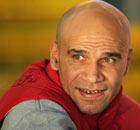 Photograph: Getty Images
Photograph: Getty Images
"Graffiti was a perfect way out. I didn't finish my education, I was a bit of a layabout, but between 1983 and 1986 I was painting all over Bristol. Through that I got into more abstract work from New York, Jean Michel Basquiat and Keith Haring, then I started stenciling. That's the stuff Banksy always says made the most impact on him. I first met Goldie at the Bristol Arnolfini exhibition in 1985, which I think was the first in this country to put graffiti in a gallery and suddenly validate us. I spent a mad night painting with him on this massive municipal housing estate in Wolverhampton. We painted until dawn and then found out someone had painted "Niggers did this" on it as soon as we'd crashed out; it'd gone before we'd had a chance to look at it but Goldie found the guy. He almost beheaded him with a spade."
(...)
HELIGOLAND (2010) New Massive Attack album art banned on London Underground
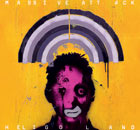
"We can't use any of the Heligoland artwork I've painted for the posters on London Underground. They won't allow anything on the tube that looks like 'street art'. They want us to remove all drips and fuzz from it so it doesn't look like it's been spray-painted, which is fucking ridiculous. It's the most absurd censorship I've ever seen. We're hosting pop-up galleries [on] tour this year. We've got UnitedVisualArtists; Steve Bliss's No Protection artwork which was like an early prototype for his Grand Theft Auto stuff; and all the extras from Mezzanine and 100th Window."
'Paradise Circus':
WHERE BRITAIN MEETS AFRICA
Massive Attack's Robert Del Naja's second release on his Battle Box label is a heavy, electronic collaboration with Congolese musician Jupiter Robert Del Naja & Jupiter Bokonjdi, the pair having met on an Afrika Express adventure in 2012.
Released on October 17 by The Vinyl Factory as a limited hand-numbered pressing of 300 with exclusive sleeve artwork by Paul Insect.
--
VISUALS, SOUNDS AND MORE
See more painting on this blog: http://propracthat.blogspot.fr/2013/01/robert-del-naja.html
Similar to Goldie, Del Naja often works with stencils, and his output varies greatly from Goldie's and other previously mentioned stencil artists such as Banksy. These in combination can be used to effectively demonstrate the flexibility offered by a single technique and medium, something which I am seeking to incorporate in my accessibility vision.
Del Naja's work also needs to be carefully considered, as a lot of it is politically motivated and the imagery used can be quite alienating, similar visually to that of Francis Bacon's paintings. Again, setting and context need to be considered before I use these examples.
--Del Naja's work also needs to be carefully considered, as a lot of it is politically motivated and the imagery used can be quite alienating, similar visually to that of Francis Bacon's paintings. Again, setting and context need to be considered before I use these examples.
Another article: https://artformusic.wordpress.com/2013/05/30/massive-attack-robert-3d-del-naja/
MASSIVE ATTACK’S ROBERT “3D” DEL NAJA | FIRE SALE
Robert “3D” Del Naja started out as a graffiti artist (he was an influence on Banksy’s formative years) and was also member of “The Wild Bunch” a sound system collective formed in Bristol during the 1980s. The collective was”a confluence of hip-hop DJs, sound-system operators and graffiti artists partly inspired by, and not dissimilar to, the late 70s New York hip-hop scene that spawned Jean-Michel Basquait.” Del Naja is similar to the likes of Basquait and Haring in the way that they all started out painting the walls on the street, only to find themselves on the walls of galleries.
It was from this collective that the hugely influential group Massive Attack emerged, the three founding members being Del Naja, Andrew “Mushroom” Vowles and Grant “Daddy G” Marshall. The group has been hugely influential and their 1991 album, Blue Lines has been “credited with revitalizing British dance music,” the seminal debut album creating a distinctive sound that became regularly imitated. They followed upBlue Lines with Protection (1994), Mezzanine(1998), 100th Window (2003) and Heligoland(2010) with a few compilation albums and soundtracks in between. Mezzanine, the groups most successful commercial album marked the departure of Andrew Vowles from the group shortly after the release due to creative differences. For 100th Window, Del Naja was the only member of the original trio to a feature with Vowles no longer in the group and Grant Marshall unwilling to take part in the making of the record. Marshall later rejoined Del Naja for the creation of Heligoland.
3D’s background in graffiti has since expanded into painting and digital art. He created the artwork for all of Massive Attack’s albums, often collaborating with Tom Hingston. Together they created album artwork and packaging for the studio albums Mezzanine, 100th Window and Heligoland and compilation album Collected often enlisting the help of photographer Nick Knight to generate imagery. You can see photographs of their work on Hingston’s portfolio under clients. Hingston describes the process of working with Del Naja as organic,
Del Naja seems fascinated with how the listener interacts with the music they create. This can be seen with the packaging for Massive Attacks Singles 90/98 boxset which featured heat sensitive packaging. The thermally sensitive ink turned white when heat was applied or was touched. Scroll down a page from this link to see a photo. Packaging like this is not surprising however as the original intentions for Massive Attack were to have a multimedia aspect in order to ‘create music around art.’ It is interesting how this group placed an emphasis on the multimedia aspect of music and also their performances, becoming well known for having impressive lighting during shows made with the help of United Visual Artists.
--MORE ABOUT STREET ART IN BRISTOL
Link: http://www.culturalweekly.com/bristol-street-art/
An Introduction to Bristol Street Art and Graffiti
Nestled beneath one of the world’s most famous bridges, designed and built by one of history’s most famous engineers, Brunel’s Clifton suspension bridge acts as an all seeing eye. Gazing over an area of the United Kingdom that has become a leader in creativity, largely with its foundations in non-traditional and non-academic platforms, Bristol continues to amaze, break new ground and be ahead of the game, time after time.
If you are not aware of Bristol, you should be. Actually, you probably are, but you just don’t know it yet. When cities boast of their achievements, the traditionalists amongst us turn to the pot of statistics that all local authorities have, such as crime, schooling and financial wealth. Bristol though has the alternative, balancing heritage with free-thinking progression. If Bristol was a person it would be Richard Branson, tattooed from head to toe. You know the type: those who work damn hard, take the right risks and don’t really care for convention.
So why this type of introduction to an article about Bristol’s world renowned street art and graffiti? Well for those of you that haven’t had the pleasure of spending time in our happy city, the photos you’ll see of 50 metre tall painted buildings and whole streets decorated from top to bottom just don’t do it justice. It’s like your first visit to New York City—those skyscrapers are truly wonderful, but similarly to Bristol, it’s the content in which they live that really give it that indescribable X factor.
Referencing New York is no mistake and although early forms of graffiti go back to ancient times, it was the resurgence in the late 70s and early 80s in the subways of New York that caught the attention and imagination of the creative and, some might say, destructive streak of a few lads in the smaller, lesser known city of Bristol.
A catalyst of underground music, rebel attitude, and the introduction of aerosol paint fused together to bring the world the Wild Bunch. Active member ‘3D,’ alternatively known as Robert Del Naja and member of the UK band Massive Attack, is one of the most widely known names and influencers of this era. The wild style lettering continues to influence today’s graffiti artists, otherwise known as graffiti writers.
It was the second and third generation of Bristol graffiti artists inspired by the Wild Bunch that has really given Bristol its reputation as a publicly creative hub. Artists such as Inkie, Cheo, Paris, Nick Walker, Xenz, Jody, Kato, FLX One, Lokey, Turo, Dicy, Dale Vn Marshall, Feek and some guy called Banksy, to name but a few, went a long way to paving the way for the rest of us.
Since the Walls On Fire graffiti event in 1998, the city and its artist have led the way as street art has reached further into the accepted public realm, drawing in all manner of artist from illustrators such as Andy Council and Mr Jago, fine artists such as Andrew Colwill and Guy Denning, to contemporary artists like Lee Ellis.
For those within Bristol’s urban art scene, the explosion of community and council support can in a large part be attributed to one artist: Banksy.
From the city’s perspective, the Banksy Vs Bristol Museum exhibition in 2009, which saw over 300,000 visitors, reportedly brought £10 million into the Bristol economy. These allowed Bristol to strengthen its position as one of the world’s foremost cities for this form of public art. In 2013, Bristol played host to Europe’s largest street art festival,Upfest – The Urban Paint Festival, accommodating 300 artists from across the globe and 30,000 visitors. After a year off, the festival will return in August of 2015, once again drawing the attention of international observers on to our extraordinarily colorful and creative city, Bristol.
--More soon.
--








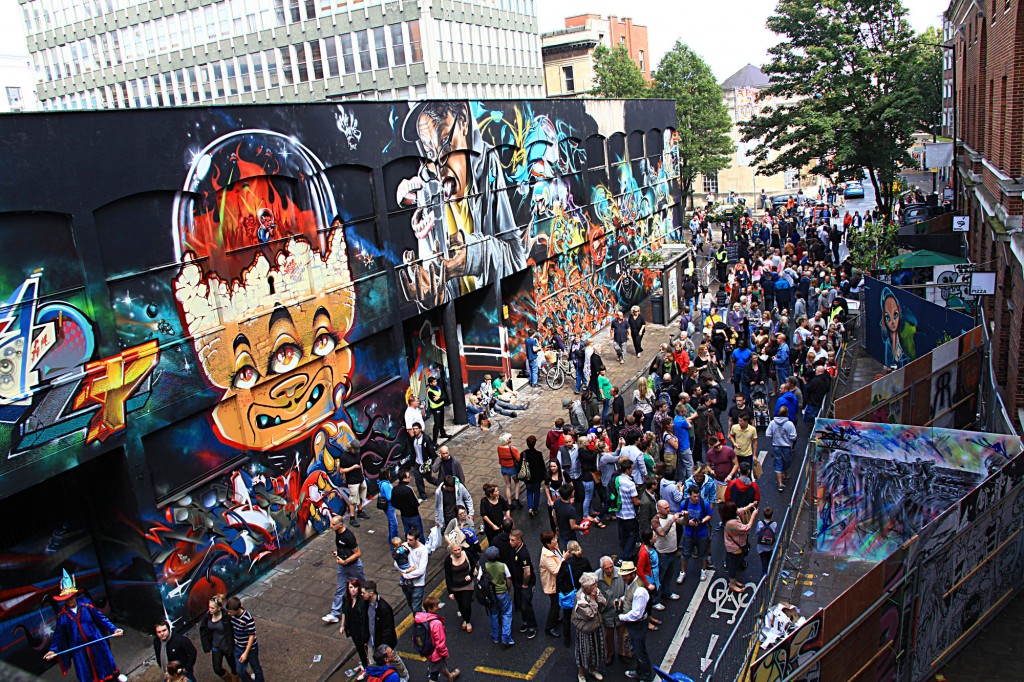
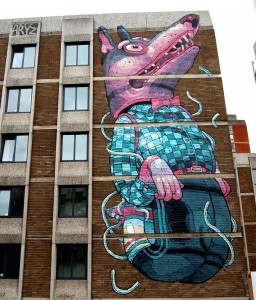
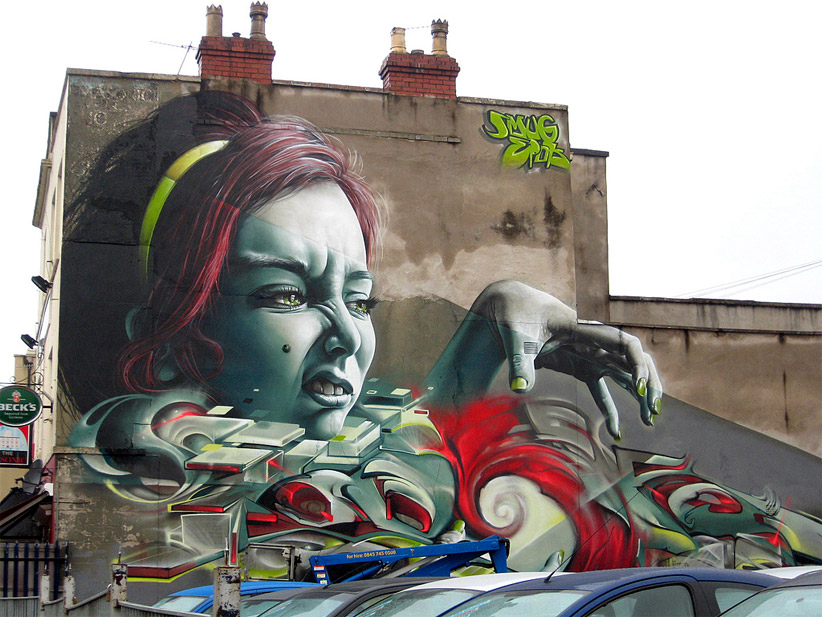
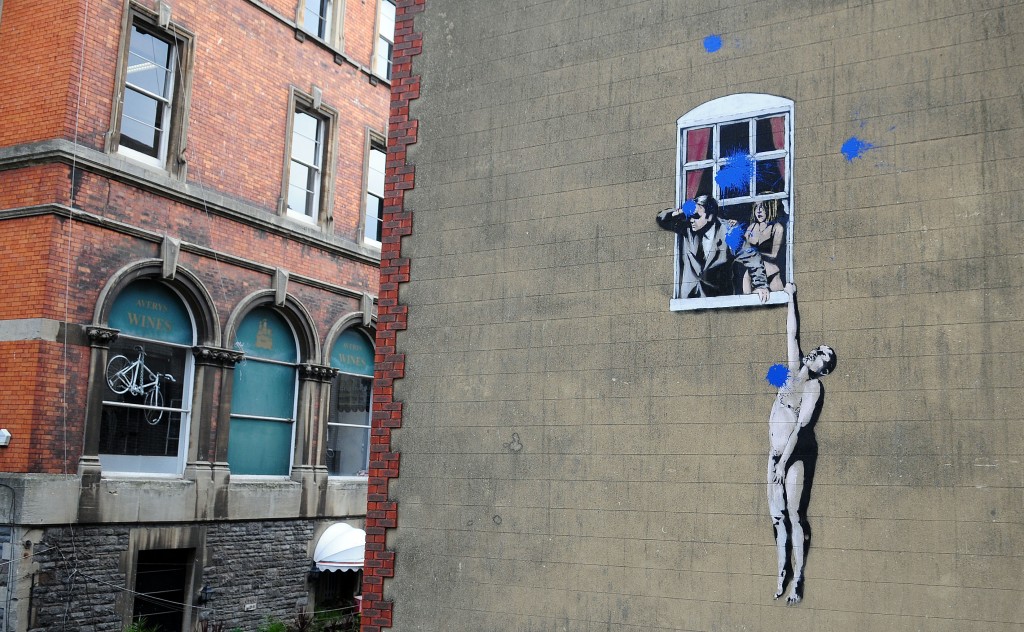
No comments:
Post a Comment